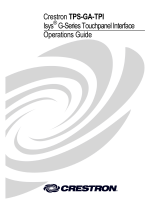Page is loading ...

CRESTRON CNOXM Oxmoor DCA-2 Interface Module
REMOTE CONTROL SYSTEMS
1 Doc. 8084
Specifications subject to change without notice. 7.95
SYNTAX:
NET.ID < 03 to FE > : CTP-3000 \ CNOXM is represented as a Touchpanel
i1,o1 = <signal name> \ Up_A Channel A Count Up Input
i2,o2 = <signal name> \ DOWN_A Channel A Count Down Input
i3,o3 = <signal name> \ PRE_A Channel A Preset Input
i4,o4 = <signal name> \ PRI_A Channel A Priority Input
i5,o5 = <signal name> \ UP_B Channel Count Up Input
i6,o6 = <signal name> \ DOWN_B Channel B Count Down Input
i7,o7 = <signal name> \ PRE_B Channel B Preset Input
i8,o8 = <signal name> \ PRI_B Channel B Priority Input
AI1 = <signal name> \ VOL_A Channel A analog volume setting to DCA-2
AI2 = <signal name> \ VOL_B Channel analog volume setting to DCA-2
AN1 = <signal name> \ VOL_A_FB Ch A analog feedback volume from DCA-2
AN2 = <signal name> \ VOL_B_FB Ch B analog feedback volume from DCA-2
DESCRIPTION:
The Crestron CNOXM is designed to control the Oxmoor DCA-2 Digital Control Attenuator via CRESNET II. The CNOXM
displays the volume of both DCA-2 channels on Cresnet-II Touchpanels and bargraph displays. The CNOXM may be thought
of as two Oxmoor RC-16 Remote Control Units.
The Oxmoor DCA-2 controls two discrete audio channels, A and B. Volume is controlled in 29 steps of 1.5 dB attenuation
from 0 dB to -43.5 dB, with the 30th step for -90 dB "full kill" attenuation. The remote inputs can be "daisy-chained" with
multiple RC-16 Remote Control Units.
The Crestron CNOXM has been designed to take advantage of the unique features of the Oxmoor DCA-2 while remaining
compatible with the standard SIMPL programming conventions used for the CNVCP-3(2) cards. The SIMPL RAMP and
PRESETV analog output signals can drive the CNOXM directly. Note that AV applications may benefit from the standard
MXB scaling of 0 to -30 dB as used with the CNVCP-3(2) cards to limit the volume control range in Presentation settings.
The most eye-catching feature of the CNOXM is the perfect tracking of the DCA-2 volume. The CNOXM reads the volume
feedback signals directly from the DCA-2. Touchpanels and/or bargraphs always indicate the correct volume. Spinning the
knob on an RC-16 connected the CNOXM/DCA-2 ramps the CRESNET II bargraphs in perfect synchronization with the RC-
16 LED's. Changing the volume on one unit updates the displays on all units, be it RC-16's or CNOXM's.
Additional features are the "Preset" and "Priority" attenuation levels. The levels for both channels are set on the rear panel.
"Preset" is the volume the DCA-2 is set to when it is powered-up and can be recalled at any time. Either or both channels
may be recalled to the "Preset" level by momentarily asserting the "Preset" signal inputs. "Priority" is a temporary setting
that can be used for paging functions. The volume will return to the previous level after the "Priority" signal input is de-
asserted.

CRESTRON CNOXM Oxmoor DCA-2 Interface Module
REMOTE CONTROL SYSTEMS
2 Doc. 8084
Specifications subject to change without notice. 7.95
CABLING AND CONNECTIONS:
Standard 4 or 6-conductor, modular telephone cables are used to interconnect the CNOXM to the DCA-2 and RC-16. (The
4-conductor cables may be used when "Preset" and "Priority" functions are not required). Typically, RJ-12 style 6-conductor
cables with RJ-11 size connectors are used. Refer to Oxmoor Model DCA-2 / Model RC-16 Installation and Operation
Manual (PN 1700001) for further details.
NOTE: In order for the CNOXM to correctly register feedback, BOTH channels of the DCA-2 must be connected to the
CNOXM.
It is possible to control multiple DCA-2 channels with one RC-16 as in a typical room combining system. The SIMPL
ABUFFER can drive multiple channel volumes with the volume feedback from one channel. A simple example of a four room
combining system uses two DCA-2's, two CNOXM's and four RC-16's. When the rooms are separated, each RC-16
controls the volume of it's respective room. In the combined mode, CNIN inputs enable ABUFFER's to give any of the RC-16's
control of all four channel volumes.
Each unique component on the CRESNET II network requires the setting of an identity code (ID CODE). ID CODEs are two-
digit hexadecimal numbers, from 10 to FE. The ID CODE of the CNOXM should be set to match the ID CODE specified in the
NET.ID statement of the CRESNET II SIMPL program (see syntax above). To set an ID CODE, disconnect power. Notice two
miniature rotary switches identified as H and L. These 16- position hexadecimal switches can be set to 0 through F. Using
a small screwdriver, rotate the arrow in the center of the switch marked H to point to the first (or most significant) digit or
letter of the specified ID CODE. Set the switch marked L to the second ( least significant) digit or letter of the specified ID
CODE.
The 4-pin connector marked NET should be wired to the CRESNET II network. Network termination points are available at
the control system power supply. Network units may also be daisy-chained together. See the CRESNET II manual section
on CNPWS power supplies (Doc. 8017) for wire gauge specifications and connection detail.
The CNOXM has an indicator marked NET POWER. This indicator is lit when 24 volts is supplied to the unit over the
network. The indicator marked ID SELECT is lit when the CRESNET II system is communicating with the unit. This indicates
that the ID CODE of the CNECI-4 matches the ID CODE of a network unit in the SIMPL program which is currently running in
the CRESNET II system.
SPECIFICATIONS:
Enclosure: Black semi-gloss steel Dimensions: 7.5"(D) X 3"(W) X 1.5"(H)
POWER FACTOR:
1.0 watt
REQUIREMENTS:
CRESNET II Workshop Version 4.00 or later.
CRESNET II Operating System SR30160.OPS or later.
/



